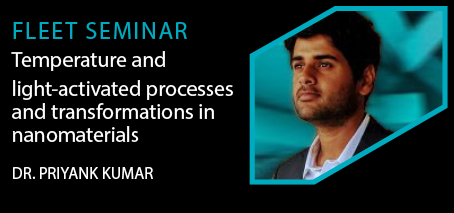-
5 Jun 2019
11:00 am - 12:00 pm
Dr Priyank Kumar
TITLE Temperature and light-activated processes and transformations in nanomaterials
VENUE: Old Main Building K15, G59
DATE: Wednesday 5th June 11:00-12:00
Abstract:
External stimuli such as temperature and light can activate different physical processes in nanomaterials and induce interesting phase/chemical transformations. For instance, transformations induced by temperature are phonon-driven and proceed along a ground-state potential energy surface (PES), while those induced by light are charge-carrier-driven and proceed along an excited-state PES pathway. Researchers have constantly sought new ways to utilize these processes efficiently for applications in low-energy electronics, optoelectronics, catalysis, health-care and so on.
In the first part of my talk, I will focus on temperature-induced transformations by taking the example of an atomically-thin oxidized form of carbon called graphene oxide (GO). Although GO has been utilized for multiple applications, our understanding of the structure-property relationships at the atomic-level has still been lacking owing to the amorphous nature and chemical inhomogeneity of GO. I will show that a novel phase transformation can occur in GO at low annealing temperatures, which enhances its optical, electrical and chemical properties significantly. I will then show how this phase transformation can be used to improve the fabrication of graphene thin-films and for applications in biomedical cell-capture devices.
In the second part of my talk, I will focus on light-induced transformations. In this regard, I will talk about metallic nanoparticles of Ag, Au, Al etc. that can concentrate optical energy and convert them to other useful forms via plasmon formation and decay to energetic charge carriers. However, current devices using these concepts suffer from poor conversion efficiencies. I will highlight key bottlenecks to this shortcoming, and discuss how recently developed ab initio methods based on density functional theory (DFT) and time-dependent DFT (TDDFT) can be utilized to address them – a daunting task to achieve in experiments. I will then talk about suitable ways to overcome such bottlenecks, which could lead to more efficient plasmonic hot-carrier devices.
BIO
Dr. Priyank Vijaya Kumar obtained his PhD in June 2015 under the guidance of Prof. Jeffrey C. Grossman in the department of materials science and engineering at the Massachusetts Institute of Technology, USA. His dissertation focused on the atomistic computational design of atomically-thin materials for electronic, optoelectronic and biomedical applications. He was also closely involved with experiments in the group of Prof. Angela Belcher at MIT. Following his PhD, he won a Marie-Curie grant to carry out his postdoctoral research in the group of Prof. David J. Norris at ETH Zurich, Switzerland. He applied ab initio methods such as density functional theory (DFT) and time-dependent DFT (TDDFT) to investigate plasmonic hot-carrier processes with an aim to advance applications including photocatalysis, photodetectors, photovoltaics and photon upconversion. In May 2019, he started as a Scientia fellow (level B) in the school of chemical engineering at UNSW, Sydney with a vision to establish a computational materials design group and foster experimental collaborations.
Venue: G59-G60, Old Main Building K15
Address:

